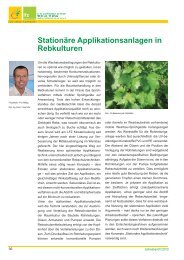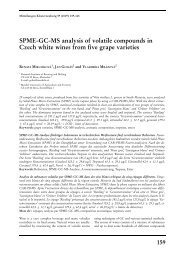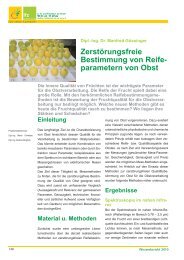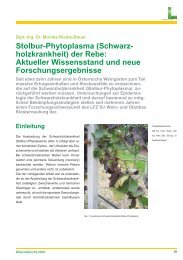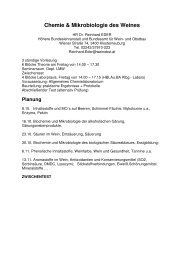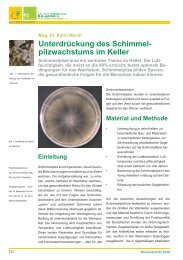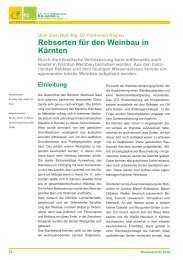Correspondence between gibberellin-sensitivity and pollen tube ...
Correspondence between gibberellin-sensitivity and pollen tube ...
Correspondence between gibberellin-sensitivity and pollen tube ...
You also want an ePaper? Increase the reach of your titles
YUMPU automatically turns print PDFs into web optimized ePapers that Google loves.
Mitteilungen Klosterneuburg 59 (2009): 129-133<br />
BoÈ ll et al.<br />
1985; SINGH et al., 2002). The results of the <strong>pollen</strong> <strong>tube</strong><br />
analyses of a broad spectrum of additional varieties<br />
with known GA <strong>sensitivity</strong> reported here strongly support<br />
our hypothesis: sensitive varieties such as 'Sylvaner',<br />
'Traminer' <strong>and</strong> 'Kerner' were found to have a distinctly<br />
lower <strong>pollen</strong> <strong>tube</strong> abundance than the less sensitive<br />
Pinot varieties. Only 'Riesling' is difficult to classify<br />
along these lines, as it exhibits differential <strong>gibberellin</strong><br />
sensitivities in different studies as well as at different<br />
sites (HILL et al., 2003; JULLIARD <strong>and</strong> BALTHAZARD, 1965;<br />
WALG, 2005), including moderate to strong side effects,<br />
that might depend on the cultivated clone. Furthermore,<br />
'Riesling' responds to GA applications with an<br />
increase instead of a thinning of the developing berries<br />
that are, however, much smaller than untreated berries<br />
due to induced parthenocarpy.<br />
Our results imply that a simple microscopic analysis of<br />
the <strong>pollen</strong> <strong>tube</strong> abundance of varieties with hitherto unknown<br />
<strong>gibberellin</strong> <strong>sensitivity</strong> might well indicate the<br />
endogenous GA status of a given variety which in turn<br />
is expected to predict the <strong>sensitivity</strong> to exogenous<br />
GA 3 -treatment including possible adverse side effects.<br />
Acknowledgements<br />
We would like to thank ANJA LIEBRANDT, MONIKAADEL-<br />
HARDT<strong>and</strong> ASTRID BAUMANN for their valuable technical<br />
assistance. We would also like to thank THOMAS JAR-<br />
CHAU for constructive comments on the manuscript.<br />
This work was supported by the Forschungsring Deutscher<br />
Weinbau (grant 8503.187)<br />
References<br />
ALLEWELDT, G. 1967a: Physiologie der Rebe. Forschungsergebnisse<br />
der Jahre 1956-1960. Vitis 6: 48-62<br />
ALLEWELDT, G. 1967b: Physiologie der Rebe. Forschungsergebnisse<br />
der Jahre 1961-1964. Vitis 6: 63-81<br />
BOÈ LL, S., HOFMANN, H. und SCHWAPPACH, P. 2009: Einsatz der<br />
Wachstumsregulatoren Gibb3 und Regalis - warum Sorten<br />
unterschiedlich reagieren. Rebe und Wein (5): 24-27<br />
HILL, G., HILL, M. und BUTTERFASS, J. 2003: Gibberelline - kleiner,<br />
weniger, besser? Dt. Weinmagazin (19): 32-35<br />
HILL, M. B. 2003: Chemische AusduÈ nnung und deren Auswirkung<br />
auf die Rebe. Unpublished diploma thesis, Geisenheim<br />
2003<br />
HOFMANN, H. 2004: Traubendesign zur FaÈulnispraÈvention.<br />
Rebe und Wein (5): 14-17<br />
IZHAKI, A., BOROCHOV, A., ZAMSKI, E. <strong>and</strong> WEISS, D. 2002: Gibberellin<br />
regulates post-microsporogenesis processes in<br />
petunia anthers. Physiologia plantarum 115: 442-447<br />
JULLIARD, B. et BALTHAZARD, J. 1965: Effets physiologiques de<br />
l'acide gibbeÂrellique sur quelques varieÂteÂs de vigne (Vitis<br />
vinifera L.). Ann. AmeÂlior. Plantes 15: 61-78<br />
KAST, W., FOX, R. und SCHIEFER, H.-C. 2005: Chancen und Risiken<br />
des Einsatzes von Gibb3. Rebe und Wein (5): 16-<br />
19<br />
LANGE, T., KAPPLER, J., FISCHER, A., FRISSE, A., PADEFFKE, T.,<br />
SCHMITTKE, S. <strong>and</strong> PIMENTA LANGE, M.J. 2005: Gibberellin<br />
biosynthesis in developing pumpkin seedlings. Plant<br />
Physiol. 139: 213-223<br />
PETGEN, M. 2004: Was bringen Gibberelline? Dt. Weinmagazin<br />
(3): 28-32<br />
PHARIS, R.P. <strong>and</strong> KING, R.W. 1985: Gibberellins <strong>and</strong> reproductive<br />
development in seed plants. Ann. Rev. Physiol. 36:<br />
517-568<br />
PIMENTA LANGE, M.J. <strong>and</strong> LANGE, T. 2006: Gibberellin biosynthesis<br />
<strong>and</strong> the regulation of plant development. Plant<br />
Biology 8: 281-290<br />
132



